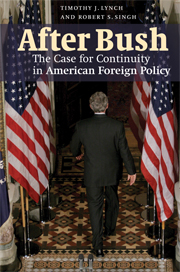Book contents
- Frontmatter
- Contents
- List of figures
- Acknowledgements
- Introduction: Winning the Second Cold War
- Chapter 1 Bush and the American foreign policy tradition
- Chapter 2 The constitution of American national security
- Chapter 3 The Second Cold War on Islamist terror: negative audits
- Chapter 4 The Second Cold War on Islamist terror: a positive audit
- Chapter 5 Iraq: Vietnam in the sand?
- Chapter 6 The Middle East: reformation or Armageddon
- Chapter 7 Frineds and foes after Bush
- Chapter 8 The emerging consensus at home and aborad
- Conclusion: The case for contiuity
- Notes
- Bibliography
- Index
Chapter 1 - Bush and the American foreign policy tradition
Published online by Cambridge University Press: 22 September 2009
- Frontmatter
- Contents
- List of figures
- Acknowledgements
- Introduction: Winning the Second Cold War
- Chapter 1 Bush and the American foreign policy tradition
- Chapter 2 The constitution of American national security
- Chapter 3 The Second Cold War on Islamist terror: negative audits
- Chapter 4 The Second Cold War on Islamist terror: a positive audit
- Chapter 5 Iraq: Vietnam in the sand?
- Chapter 6 The Middle East: reformation or Armageddon
- Chapter 7 Frineds and foes after Bush
- Chapter 8 The emerging consensus at home and aborad
- Conclusion: The case for contiuity
- Notes
- Bibliography
- Index
Summary
War is God's way of teaching Americans geography
Ambrose Bierce, c. 1900In this chapter we argue that the war on terror – the Second Cold War – is better understood as a revision rather than a rejection of the dominant American foreign policy tradition. Indeed, the war's durability as a strategy, and the prospects for its ultimate success, flow from its unification of the different strands of that tradition. These are enumerated below and the Bush foreign policy weighed against them. In what follows we place the Second Cold War on a wide historical canvas. In the next chapter we consider in more detail Bush's use of the American ‘national security constitution.’ Continuity, not change, is the hallmark of each.
Is there a US foreign policy tradition?
‘Tradition,’ as a concept, is difficult to define with precision. It smacks of what international relations theorists term ‘unit-level variables’: national character and custom, particularity and idiosyncrasy, history and experience. Identifying a distinctive foreign policy tradition inevitably involves the scholar in this often fuzzy realm of analysis. Attempts at definition are invariably normative. That is, scholars define a foreign policy tradition that is consonant with their generalized view of American conduct. Walter Russell Mead, for example, observes ‘a special providence’ in the history of US foreign policy that accounts for its utility – ‘American foreign policy works,’ he says.
- Type
- Chapter
- Information
- After BushThe Case for Continuity in American Foreign Policy, pp. 17 - 45Publisher: Cambridge University PressPrint publication year: 2008



